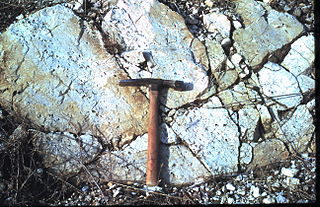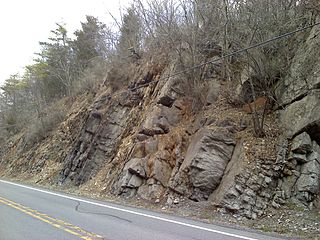Related Research Articles

Conodonts are extinct agnathan (jawless) vertebrates resembling eels, classified in the class Conodonta. For many years, they were known only from their tooth-like oral elements found in isolation and now called conodont elements. Knowledge about soft tissues remains limited. The animals are also called Conodontophora to avoid ambiguity.

The Llano Uplift is a geologically ancient, low geologic dome that is about 90 miles (140 km) in diameter and located mostly in Llano, Mason, San Saba, Gillespie, and Blanco counties, Texas. It consists of an island-like exposure of Precambrian igneous and metamorphic rocks surrounded by outcrops of Paleozoic and Cretaceous sedimentary strata. At their widest, the exposed Precambrian rocks extend about 65 miles (105 km) westward from the valley of the Colorado River and beneath a broad, gentle topographic basin drained by the Llano River. The subdued topographic basin is underlain by Precambrian rocks and bordered by a discontinuous rim of flat-topped hills. These hills are the dissected edge of the Edwards Plateau, which consist of overlying Cretaceous sedimentary strata. Within this basin and along its margin are down-faulted blocks and erosional remnants of Paleozoic strata which form prominent hills.

Hindeodus is an extinct genus of conodonts in the family Anchignathodontidae. The generic name Hindeodus is a tribute to George Jennings Hinde, a British geologist and paleontologist from the 1800s and early 1900s. The suffix -odus typically describe's the animal's teeth, essentially making Hindeodus mean Hinde-teeth.

The Bend Arch–Fort Worth Basin Province is a major petroleum producing geological system which is primarily located in North Central Texas and southwestern Oklahoma. It is officially designated by the United States Geological Survey (USGS) as Province 045 and classified as the Barnett-Paleozoic Total Petroleum System (TPS).
Paleontology or palaeontology is the study of prehistoric life forms on Earth through the examination of plant and animal fossils. This includes the study of body fossils, tracks (ichnites), burrows, cast-off parts, fossilised feces (coprolites), palynomorphs and chemical residues. Because humans have encountered fossils for millennia, paleontology has a long history both before and after becoming formalized as a science. This article records significant discoveries and events related to paleontology that occurred or were published in the year 1959.
Paleontology or palaeontology is the study of prehistoric life forms on Earth through the examination of plant and animal fossils. This includes the study of body fossils, tracks (ichnites), burrows, cast-off parts, fossilised feces (coprolites), palynomorphs and chemical residues. Because humans have encountered fossils for millennia, paleontology has a long history both before and after becoming formalized as a science. This article records significant discoveries and events related to paleontology that occurred or were published in the year 1931.
Taphrognathus is an extinct genus of conodonts from the Dinantian.

The Devonian Old Port Formation is a mapped bedrock unit in Pennsylvania, USA. Details of the type section and of stratigraphic nomenclature for this unit as used by the U.S. Geological Survey are available on-line at the National Geologic Map Database. Current nomenclature usage by U.S. Geological Survey restricts the name Old Port Formation to Pennsylvania, but correlative units are present in adjacent states.

The Late Silurian to Early Devonian Keyser Formation is a mapped limestone bedrock unit in Pennsylvania, Maryland, Virginia, and West Virginia.
The Chappel Limestone is a geologic formation in Texas. It preserves fossils dating back to the Carboniferous period.
Maurice Goldsmith Mehl was an American paleontologist. A longtime professor in the Department of Geology at the University of Missouri, Mehl was a founding member and officer of the American Association of Petroleum Geologists. Mehl was a fellow of the Geological Society of America (1922), the Paleontological Society, and the American Association for the Advancement of Science.
Edward B. Branson was an American geologist and paleontologist. He worked at the University of Missouri.
Spathognathodontidae is an extinct conodont family ranging from the Silurian to the Devonian.
George Jennings Hinde was a British geologist and paleontologist.
Carniodus is a conodont genus from the Silurian.
Ctenognathodus is an extinct conodont genus in the family Kockelellidae.
Spathognathodus is an extinct conodont genus in the family Spathognathodontidae. It is a non-Platform conodont, from the Pennsylvanian (Carboniferous).
Icriodus is an extinct conodont genus in the family Gnathodontidae.
William Madison Furnish was an American paleontologist. He taught at the University of Iowa.
Dollymae is an extinct genus of conodonts.
References
- ↑ Morphology of Conodonts. Wilbert H. Hass, Journal of Paleontology, Vol. 15, No. 1 (Jan., 1941), pp. 71-81 (Stable URL)
- ↑ Orientation of the Crystal Units of Conodonts. Wilbert H. Hass and Marie L. Lindberg, Journal of Paleontology, Vol. 20, No. 5 (Sep., 1946), pp. 501-504 (Stable URL)
- ↑ Conodonts of the Barnett Formation of Texas. Wilbert H. Hass, 1952
- ↑ Conodonts from the Chappel limestone of Texas. Wilbert H. Hass, 1959